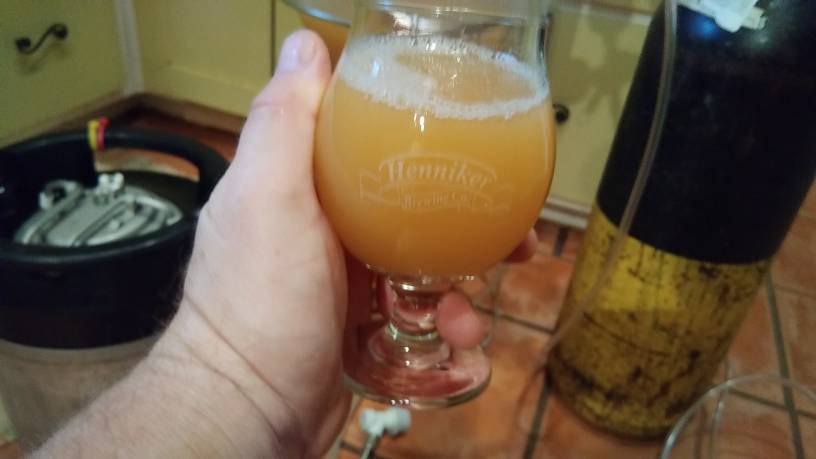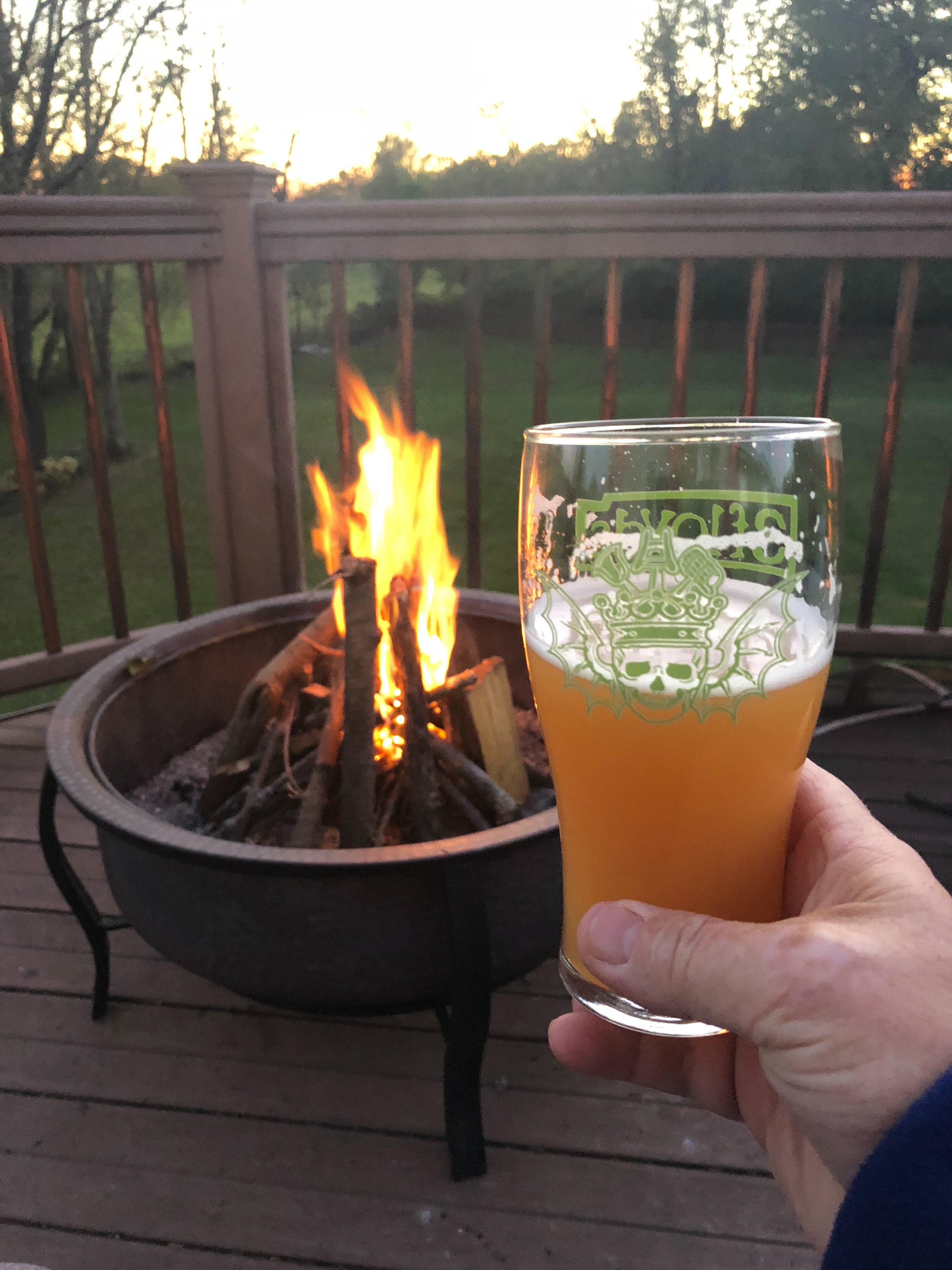Redtab78
Well-Known Member
the tricky part is waiting the 6 days or so after to get the taste lol

Yeah, already up to 9 psi. Bled a little off and the aroma was heavenly! I'll likely pull off a sample to check gravity in about 3-4 days.the tricky part is waiting the 6 days or so after to get the taste lol
1.) Hop bill:
I use 25oz into 7.5gal batch into fermenter.
1oz Boil
8oz whirlpool
8oz biotrans dryhop @ 72hrs
8oz aroma dryhop (after cold crash), day 10
For the aroma dryhop, I split the finished beer between two kegs, each contains 4oz of different hops. Accounting for losses, I usually end up with 6-6.5gal of drinkable beer. When pouring the beer, the aroma is detectable across the room. Flavor: my buddies and I used to think Treehouse made the best beer....
2.) Ferm temp - depends on yeast
Conan - 63 thru day 4 then ramp up to a couple of degrees each day to get to 70 before crashing
1272 - 65 thru day 4 then ramp up to a couple of degrees each day to get to 72 before crashing













Add Lake Time Brewing to your list to check out. Just across the border into Iowa in Clear Lake. My sister bought the beer in the photo for me and will be bringing it to me at Christmas. I can't wait. NEIPA brewed with Kveik yeast! The reviews on Untapped are very high!Thanks ttuato! 25 ounces of hops for a 7.5 gallon batch is certainly in line with 20 ounces for my 6 gallon batch. I'm also going to try ramping up to 72 degrees after four days at 65.
Taste is subjective, of course, but I always wonder if some of the folks who are using comparatively little hops have tasted the huge NEIPA juice bombs. I mean, that recipe I posted from Zymurgy had 4 ounces of hops total! There's just no way that results in a juicy NEIPA.
I've never had Treehouse beers, but in my neck of the woods (Minneapolis), we have some awesome NEIPA's from Toppling Goliath (Iowa), Drekker Brewing (North Dakota) BlackStack Brewing (Minneapolis), Fair State Brewing (Minneapolis), Barrel Theory (St. Paul) and Lupulin Brewing (Big Lake, Minnesota).


are people zeroing in on favorite neipa yeast at this point? i think my favs are 1318, 1272 and the sacch trois strain or anything combined with sacch trois
That's where I've been too...nice balance to the juice bombs.I have a batch of this and a batch of my Hoppy Session Wheat heading into kegs in the next day or two..... been a while since I have brewed them, so, looking forward to having something hoppy back on tap. Currently, I have 6 lagers on tap!
Add Lake Time Brewing to your list to check out. Just across the border into Iowa in Clear Lake. My sister bought the beer in the photo for me and will be bringing it to me at Christmas. I can't wait. NEIPA brewed with Kveik yeast! The reviews on Untapped are very high! View attachment 595524

are people zeroing in on favorite neipa yeast at this point? i think my favs are 1318, 1272 and the sacch trois strain or anything combined with sacch trois
I would like to thank everyone who has contributed to this thread. It taught me a lot about this style and how to do a good job brewing it. This is the result is quite delicious. Here is the recipe.
9 lb Briess 2 row
1 lb Honey malt
2 lb White wheat malt
0.5 lb lactose
Imperial Juice yeast
1 oz Nuggett (12.1aa) 60 min
1.5 oz each (when wort is cooled to 170 through chilling) Citra, Azecca, Idaho 7, and Vic Secret
1 oz each of Citra, Azecca, Idaho 7, and Vic Secret at 3 days during full kreusen
1/2 oz each Citra, Azecca, Idaho 7, and Vic Secret at day 14
Kegged and allowed to crash in the keg. There was no water adjustment as my county in KY uses Cincinnati water and it's pretty good.View attachment 595517 View attachment 595517
Agree 100%, had my last NEIPA finish at 1.013 with 4oz of honey in a 14lb grain bill and it is sweeter than expected. I just kegged one w/o honey and will do a side by side to compare.@Eric Tepe - looks great and sounds like a tasty hop combo.
One suggestion for you on the next iteration - try dialing the honey malt back to no more that 8oz in 5 gal batch (I use 6oz in 7.5 gal). That is some surprisingly powerful stuff and contributes a lot more flavor than folks realize. It becomes really obvious around 3-4weeks post brew day - a cloying sweetness that coats the tongue and is apparent for remainder of keg.
What’s your saisonrecipe? Same beer with 3711?View attachment 595680 . Citra/Galaxy saison in the glass though. Honestly, hard to beat a good saison!
@Eric Tepe - looks great and sounds like a tasty hop combo.
One suggestion for you on the next iteration - try dialing the honey malt back to no more that 8oz in 5 gal batch (I use 6oz in 7.5 gal). That is some surprisingly powerful stuff and contributes a lot more flavor than folks realize. It becomes really obvious around 3-4weeks post brew day - a cloying sweetness that coats the tongue and is apparent for remainder of keg.
What’s your saisonrecipe? Same beer with 3711?
I think it sounds like a Hop Creep... overattenuation and some diacetyl. Read about it.Guys that use WY1318 has anyone had this before ? second time using this yeast off what looked like healthy yeast starter from my first overbuild, it started off well and went from 1.054 to 1.016 in 3-4 days. Its now been going for 11 days and its still going, dropped a point over the weekend to 1.011. Getting to the point of wanting to keg / dump it and get something else on. Taste wise its not great, slick mouth feel so maybe Diacetyl.
Never had a yeast take so long and the last beer I made with this yeast was really good and finished in 6 days.
Any thoughts ?
I think it sounds like a Hop Creep... overattenuation and some diacetyl. Read about it.
View attachment 595680 Kegging some IPA’s tonight...... Citra/Galaxy saison in the glass though. Honestly, hard to beat a good saison!
I don't know if it's the honey malt doing this. I did 9 straight NEIPA brew, 4 with honey malt (2-4%), 3 without honey malt and 2 with C10. At first (3-4 weeks in the keg) the beer is really good and fresh. After a month in the keg, the beer with and without honey malt became sweet on the flavor side but still have a good aroma. I thought it was honey malt at first but when I completed deleted any sweet malt in my last 3 NEIPA, it's still the same result. Yeast was 1318, Conan and 644. I'm always doing no oxygen closed transfer.
I'm going back to honey malt in the next one with Voss Kveik in the journey for the orange-citrus flavor.
Naw, your fine...perhaps I should re-evaluate my drinking habits
Great interview with Henry from Monkish to be found here, with the first half talking a lot about the processes he uses for creating his ipas.
It's mainly interesting because the high Cl-SO4 ratio and the dry-hopping during fermentation don't seem to be that important as we all think.
Also nice to hear that his NEIPAs take 30 days from brewing before they are released in cans, mainly because of stability reasons it seems.